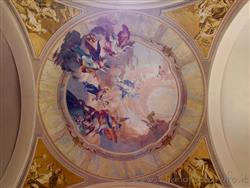|
Busto Arsizio (Varese, Italy): Church of Madonna in Prato
|
|
|
Show an other place around Milan worth a visit: |
 The church of Madonna in Prato is a small church in Busto Arsizio, belonging to the parish of San Michele Arcangelo. Formally it is entitled to the Immaculate Conception but is commonly known as Madonna in Prato ("Virgin at the lawn"). The church of Madonna in Prato is a small church in Busto Arsizio, belonging to the parish of San Michele Arcangelo. Formally it is entitled to the Immaculate Conception but is commonly known as Madonna in Prato ("Virgin at the lawn").
On the site, at the fork of the roads leading to Gallarate on the right and Verghera and Arnate on the left, a shrine containing a painting of a Nursing Virgin object of popular devotion stood since the twelfth century. The shrine was enlarged several times and fenced and, at the end of the sixteenth century, transformed into an oratory through the addition of a rectangular hall covered with wooden trusses and a flat ceiling. The shrine was thus transformed into the presbytery of the new oratory; a wrought iron gate with brass inserts separated the presbytery and the hall. In 1603, after the pastoral visit of Cardinal Federico Borromeo, the bell tower on the left and the sacristy on the right were erected on the sides of the presbytery. A new sacristy, larger, was then built at the beginning of the sixteenth century behind the altar.
In the years 1773-1774 Biagio Bellotti made radical changes to the oratory, increasing its size and transforming it into the building that is visible today. He had the back wall torn down so as to transform the second sacristy into the new presbytery, covered with an oval vaulted ceiling (Fig. 3).
The fourteenth-century chapel was moved further back and Bellotti repainted the fresco of the Virgin with Child over the original one (but the repainting was removed during the last restorations, so as to bring the original fresco of the twelfth century back to light, Fig. 4). The fresco was placed inside a magnificent trompe l'oeil altarpiece in Baroque style. A new sacristy and a new altar with scagliola frontal were built and, through the demolition of the side walls, the original now frontal hall was enlarged. This became square, with rounded corners and walls marked by Tuscan pilasters. The new roof was (and still is today) vaulted ceiling (Fig. 2).
Biagio Bellotti decorated the main vault with a fresco depicting the Glory of the Virgin with the archangel Michael; the pendentives are occupied by monochrome representations of the figures of Esther and Ahasuerus, Judith and Holofernes, David and Abigail, Giaele and Sisara. On the vault of the new presbytery an anonymous painter painted instead an allegory of obscure meaning, with angels holding the sun and the moon.
Particularly interesting are the facade and the windows.
The façade uses simple architectural elements to create a complex and original structure: the pilasters and the cornice that divides the two orders are reduced to slight projections in the plaster, the capitals to simple rectangles in relief, in stark contrast to the central window of fanciful Baroque shape and the broken pediment in which the curves of the central element contrast with the linearity of the side parts. At the apex of the pediment there is a statue of the Immaculate Virgin, while at the sides there are the statues of two cherubs who seem to look at her in admiration.
The windows, on the other hand, are present in four different forms, all of mixtilinear forms in the late Baroque style, and create breaking points in the very linear and geometric structure of the complex on which the observer's attention inevitably focuses.
Categories: Places of historical value of artistic value
Piazza A. Manzoni, 18C, 21052 Busto Arsizio VA |
Further pictures of Church of Madonna in Prato in the section Photography |